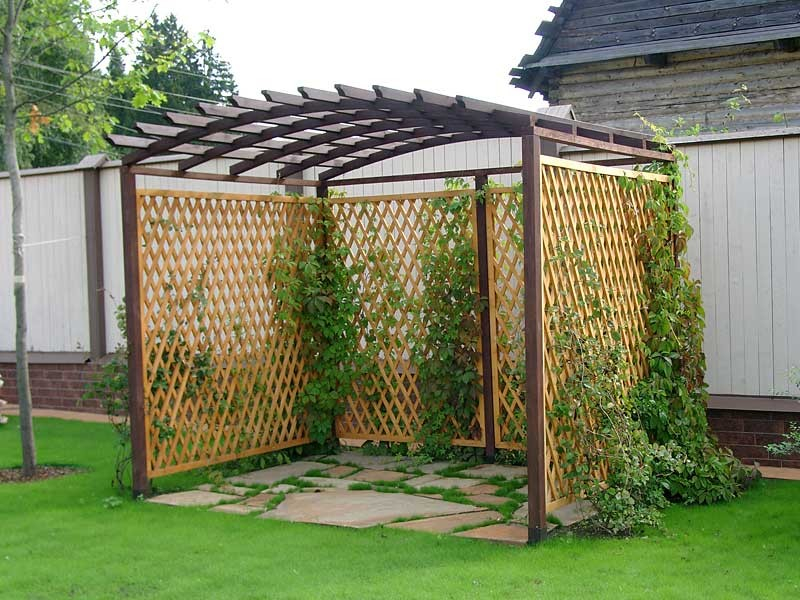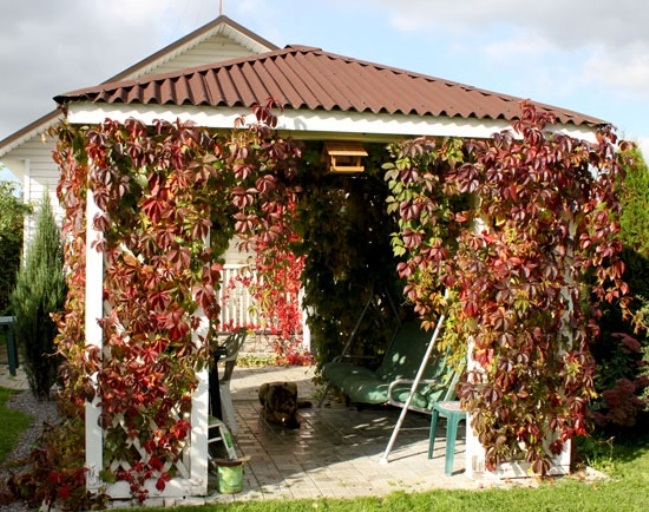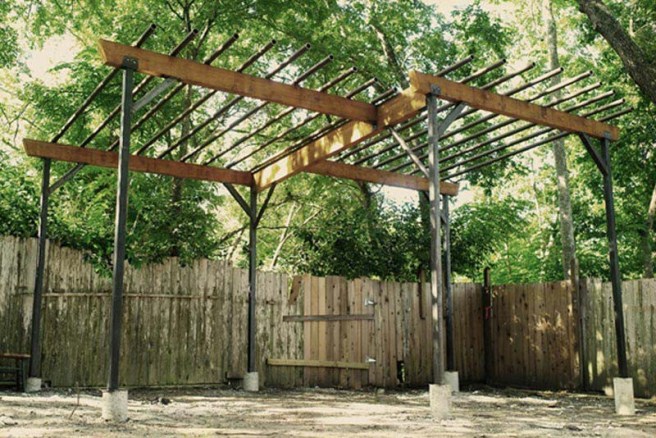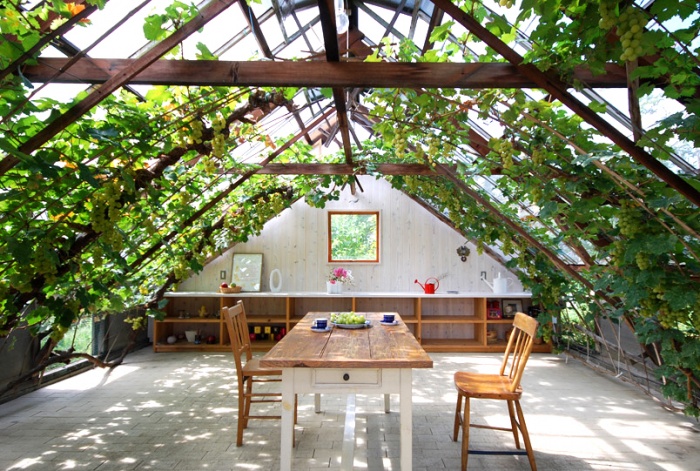Content:
A grape arbor is not only a wonderful decoration for a garden, but also a full-fledged vineyard on a small plot. The living structure, entwined with vines of grapes, serves as a cozy resting place in the shade, a shelter from the hot sun for other plants, as well as a car.
Grape variety selection
The grapevine is one of the best plants for decorating a cozy corner. It looks very impressive and gives delicious fruits, to which the hand reaches out. But not every grape variety is suitable. We need a frost-resistant, vigorous and luxuriantly growing species. However, it should bear fruit well even with minimal maintenance. The most suitable, non-covering varieties for central Russia:
- Buitur is winter-hardy, the length of the vine reaches 8 m;
- Alpha - frost resistant, productive, matures late;
- Russian concord - early harvest, sweet, vines are tall and strong;
- Amursky is a frost-resistant, vigorous variety with a rich harvest.
Suitable varieties that will need to be covered with a film for the winter:
- Malengr - early ripening, frost-resistant;
- Keshu and Keshu-1 - frost-resistant, vigorous, has large berries.
Types of arbors
The temporary-seasonal grape arbor is assembled only for the warm period, and is removed for the winter. Stationary gazebos are left at any time of the year. Most often they are made of a closed type, becoming a kind of garden houses.
Varieties of gazebos, depending on the purpose:
- Hip, domed - good for relaxation;
- Tapestry, consisting of 2 planes;
- Large square - polyhedral or rectangular design suitable for barbecuing with friends. For safety reasons, it is necessary to maintain a distance of 6 m from the house;
- The gazebo next to the building is the most budgetary, since it consists of only one wall and a top. Usually used as a shady shelter at the entrance to the premises;
- Pergola. These are several connecting arches that form a covered alley. It can serve as an extension to the house, a veranda closed by a "living" wall or partition.
Most often, the material for the frame is:
- Metal. A gazebo made of more durable material looks beautiful due to the forged decorative elements. The disadvantage of a metal gazebo is the property of iron to quickly heat up from the sun, which can damage the plant;
- Wood. Since grapes sometimes live up to 200 years, wood is not a very practical material. It looks beautiful, but it quickly decays due to watering the grapes. Antiseptics are used to increase the service life of a wooden structure.
- The structure is also made of natural stone, brick, combined building materials.
Building
First you need to pay attention to finding a suitable place for a gazebo in the garden. Usually, experienced growers install a structure in the depths of the dacha, so that the distance to the residential building is from 3 to 5 m.If it is planned to start a live fire in the hearth, then the distance is increased to 8 m.
Gazebo with foundation
This is the most expensive and difficult design option for grapes.First, the area of the structure is calculated. For a company of 4 people, a gazebo with a width of about 1.5 m and a length of 1.5 to 2 m is required. Manufacturing steps:
- First of all, the foundation is marked and made (columnar, pile, tape, monolithic). Sand, gravel and cement will be needed;
- The sides are closed. The height of the walls is selected from 50 to 100 cm so that there are no obstacles for the view. Production material: boards, stone, timber, lining, logs;
- The wooden floor should be impregnated with anti-rotting agent. You can make the flooring from ceramic tiles or decking. It is good to install a fireplace or stove in such a gazebo.
Frame made of pipes
An arbor for grapes from a profile pipe can be of almost any type: simple with sheer walls, domed, arched, multifaceted. Metal surfaces must be coated with outdoor acrylic paint.
Algorithm for making the frame:
- Mark the position of the future structure on the ground;
- If a site is needed, then the upper soft soil layer is first removed. The floor can be covered with gravel, pebbles or left earthen;
- Every 2 m, holes are dug for iron pipes, about 70 cm deep;
- Sand is poured at the bottom of each pit, a little mortar is poured, racks are installed and they are poured with concrete;
- Making a horizontal tier. Having measured 70 cm from ground level, the crossbars are welded. Then the next tier is mounted, at a distance of about 40 cm from the first;
- After the 3rd tier, they begin to mount the crossbeams on the roof. It can be of any shape: conical, pitched, domed.
An open type of gazebo, without a roof, is able to protect only from the sun. Therefore, many gardeners prefer to make a roof from roofing material. If you want to make a light and sunny gazebo, then use polycarbonate. There is also a removable roof type made of stretched waterproof fabric in the form of a tent.
Arched view of the gazebo
The gazebo is like a greenhouse, but without film. It will take only one day to build it. Manufacturing steps:
- A frame is made using metal fittings, plastic pipes;
- The rods must be given a semicircular shape and dug into the ground with their ends, filled with concrete;
- For the structure to be strong, you need to weld several guides by welding or simply fasten the arcs with wire.
The advantage of an arched gazebo is its simplicity and speed of manufacture.
Trellis
The material for the trellis from 2 planes can be wood, metal pipes, fittings. Algorithm of actions:
- Dig in the racks, fill them with concrete. It is important that there is no distortion, therefore it is necessary to check by means of a plumb line and a level. You should not make the gazebo too high so that there are no difficulties with the formation of the vine;
- If the concrete has hardened, you can start fixing the horizontal and vertical lintels. If the manufacture of the roof is not planned, then the top is done in the same way;
- The roof can be either with a slope to the south or west side, or flat.
Gazebo attached to the house
This is the simplest, budgetary and most common type. Starting near the house, at a short distance, the structure gradually goes up at an angle, ending on its roof. It is best to make a gazebo on the south or west side so that the grapes get enough sun.
Round gazebo
A round gazebo will decorate any garden. You need to profile and install pipes or beams in a circle, not forgetting to leave a place for the entrance. They should be in the shape of an umbrella. At the upper center point, the bars are joined, going down at an angle.The advantages of the round shape are the simplicity of the formation of grape vines. To do this, it is enough to plant 2 plants on the sides of the entrance. The grapes will crawl upward and further along the circumference.
The fruits of viticulture are used not only to create gazebos. In different gardens you can see grape arches, labyrinths, galleries, fairy-tale houses, green rooms. Independent production of a structure for a vineyard is available to any gardener, even without experience in construction. From the construction of a gazebo in the courtyard, he receives several advantages at once: a shelter on a hot afternoon, a harvest of delicious grapes, a place for pleasant rest, a beautiful element of garden design.
















